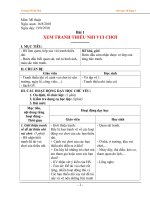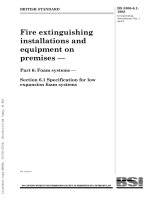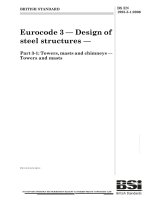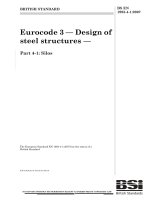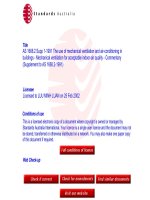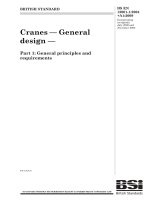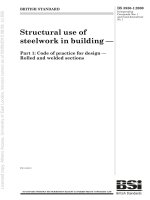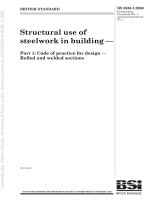Bsi bs cecc 00015 1 1991 scan
Bạn đang xem bản rút gọn của tài liệu. Xem và tải ngay bản đầy đủ của tài liệu tại đây (5.47 MB, 63 trang )
CECC
00015 :
BRITISH STANDARD
BS
I
p art1 : 1 9 9 1
Harmonized s y s tem of quality as s es s m en t
fo r el ectro ni c comp onents
B asic sp ecification:
Protection of
electrostatic sensitive
devices
Part 1 . General requirements
S y s tème haimo nis é
d’ as s uranc e d e la q u al i té
S p éc ific atio n d e b as e:
Pro tec tio n
d e s p ro duits
s ens ib les a u x déc harg es élec tro s tatiques
Parti e
1 . Règles g énérales
H armo nis iertes Güteb es tätig ung s s ys tem fü r
B auelemente
d e s c o mp o s ants élec tro niques
d e r Elektro nik
Grunds p ez ifikatio n: S c hutz vo n
Elektro s tatis c h
Teil
G e fäh rd e te n B auelementen
1. Allgemeine Anfo rdeiiing en
[
:
:
:
:
.
:--:
,
.
.
_
.,
:=
:a
.:-
.
- .
BS CECC 00015 Part 1 1991
:
:
Cornrnittees responsible for this
British Standard
T he p re p arati o n
of this B ritis h S tandard was
e n tru s te d by t h e
Elec tro nic
C o mp o nents S tandards Policy C o mmittee (ECL/- ) to Technical C o mmittee
EC L/23 , u p o n w hic h
As s o c iatio n of
t h e following b o dies w e re
Franc his ed D is trib uto is
B ritis h El e c tro - s tati c Manufac turers '
of
re p re s e nte d:
Elec tro nic
C o mp o nents
As s oc iatio n
B ritis h El e c tro s tati c C o ntro l As s ociation
B ritis h Plas tic s Federati o n
B ritis h Telec o mmunic ati o ns plc
EEA ( The As s o c iatio n of Elec tro ni c s ,
Telec o mmunic atio ns and B us ines s
Equ i p me nt Indus tries )
Elec tro nic C o mp o nents I n d u s ti y Federation
GAMBICA (BEAMA Ltd. )
He al th an d S afe ty Exec utive
Minis try of D efenc e
Natio nal S up ervis i ng I ns p e c to rate
This B riti s h
S tan d ard ,
b e e n p re p are d
di re c ti o n
u nde r
of t h e
C o mp o ne n ts
C o mmi tte e ,
Linder t h e
El e c tro n i c
S t a n d a r d s Policy
w as
O
p u b l i s he d
au th o ri ty
S t a n d a r d s B o ard
e ffe c t o n
20
hav i n g
th e
of t h e
a n d c o me s i n t o
D ec emb er
Amendments issued since publication
1 991
Amd.
B SI
1 991
T h e fo llo w ing BSI r e fe r e n c e s
re l ate t o
the
wo rk
o n thi s
s tan d ard:
C o mmi tte e r e fe r e n c e
EC L/23
D r a ft fo r c o m m e n t 9 0/24 8 09
ISBN O
580 20336 O
DC
No .
D ate
' Ikxt affe c te d
.
BS CECC 0001 5
:
Part 1
:
1 991
National foreword
This British Standard has been prepared under the direction of the Electronic
Components Standards Policy Committee. It is identical with CECC 00015/1
1991 ‘Basic Specification: Protection of Electrostatic Sensitive Devices Part 1
General requirements’, published by the CENELEC Electronic Components
Committee (CECC).
This standard supersedes BS 5783 1987 which is withdrawn. It is envisaged
that further Parts of CECC 00015 be published as follows.
CECC 00015 Part 2 Particular requirements for low humidity areas;
CECC 00015 Part Particular requirements for clean rooms;
CECG 00015 Part 4 Particular requirements for areas with high voltages
present.
On publication of the further Parts of CECC 00015 equivalent Parts of
BS CECC 00015 be published in due course.
:
:
:
will
:
:
3
:
:
:
:
will
Cross-references
International standard
Corresponding B ritish Standard
BS 6233 1982 Methods of test for volume resistivity and
IEC 93
surface resistivity of solid electrical insulating materials
(Identical)
The %chnical Committee has reviewed the provisions of IS0 2878 to which
reference is made in the text and has decided that they are acceptable for use in
conjunction
this British Standard. related British Standard to IS0 2878 is
BS 2050 1978 ‘Specificationfor electrical resistance of conducting and
antistatic products made from flexible polymeric material’,
:
with
A
:
Compliance with a British Standard does not of itself confer immunity from
legal obligations.
i
Förderverein für Elektrotechnische Normung (FEN) e.
V.
Cen el ec Electron ic Components Committee
CECC
Système Harmoni sé d’Assurance de l a Qu alité
des Composants Electroniques
SPECI FI CATI ON DE BASE:
PROTECTION DES PRODUITS
SENSIBLES AUX DECHARGES
E LECTROSTATIQ U ES
PARTIE I :
REGLES GENERALES
Harmonized System of Quali ty Assessment for
Electronic Components
BAS I C SPEC I FI CATI O N :
PROTECTION OF ELECTROSTATIC
SENSITIVE DEVICES
PART I :
GENERAL REQUIREMENTS
Harmonisiertes Gütebectätigungssystern für
Bauelemente der Elektronik
1
Edition
Issue
Ausgabe
G R U N DSPEZI FI KATI ON :
SCHUTZ VON ELEKTROSTATISCH
GEFÄHRDETEN
BAUELEMENTEN
TE I L I :
ALLGEMEINE ANFORDERUNGEN
C E C C 0 0 0 1 5/1
1 991
Pages
Contents
Foreword
4
Preface
4
Section one. General
5
1
1. 1
1 . 2
General
Scope
Definitions
5
5
5
Section two. Design consideration to minimize the effects
of ES D
2
2. 1
2. 2
2. 3
2. 4
2. 5
2. 6
Design
Identification
Design of electrostatic discharge. sensitive devices
(ESDS)
Design of assemblies
Packaging design
System design
Design evaluation procedure
Section three. Labels signs
3. 1
3. 2
3. 3
3. 4
4. 2
4. 3
4. 4
4. 5
4. 6
4. 7
4. 8
4. 9
4. 1 0
4. 1 1
fo u r .
ES D
5. 1
5. 3
5. 4
5 . 5
5. 6
8
8
9
9
9
10
marking
10
10
11
11
Protected Area (EPA)
15
Configuration
Control boundaries
Basic material requirements for use within the controlled
boundaries of all forms of ESD Protected Area (EPA)
Ionization
Humidity
Construction of the ESD protected area (EPA)
Field work
Tools
Fittings
Test and process equipment
EPA working practice
Section five. Protective
identification for ESDS
5 . 2
and
8
8
Labels
Signs for ESD protected area (EPA)
Marking of earth bonding points, earth grounding points
and ESD earth facilities
Marking of documentation
Section
4. 1
8
marking
packaging
15
1 5
1 5
18
19
19
24
25
25
26
26
and
33
Packaging materials
Intimate packaging materials
Proximity packaging material
Secondary packaging material
Marking and identification
Package/component compatability
1
33
34
34
35
35
35
CECC O0
01 5
Issue 1
BSI B S UC E C C
0 0 0 1 5: * P T* L
91
m
162 4 669I 0 2 7 1 7 8 9 1
Pages
Contents
S e ct i on six.
6. 1
6. 2
6. 3
6. 4
6. 5
6. 6
P urchas e, receipt,
36
storage and handling
36
36
36
37
37
38
General
Purchase
Receipt
Unpacking within an EPA
Goods inward inspection
Movement and handling
S ect ion seven.
Training
39
S ect ion eight.
Quality responsibilities
40
8. 1
Personnel responsibilities
8. 2
8. 3
8. 4
8. 5
8. 6
8. 7
Local co-ordinator
40
40
40
Selection of ESD materials
Procurement records
Procurement of ESDS components and subcontracted work
Des i gn
Checking of electrostatic precautions
8. 8
Frequent checks
8. 9
8. 1 0
8. 1 1
8. 1 2
Dai l y checks
Veekly checks
Monthly checks
S i x monthly
S ect ion nine.
9
41
41
41
41
41
41
43
43
43
44
Periodic audi t instructions
Periodic audit instructions
44
A
Tes t procedures
A. l
A. 2
Surface resistivity and resistance to ground
Charge decay
A . 3
Measurement
A . 4
Additional tests
A. 5
Measurement
46
46
48
49
50
51
Annex
of antistatic properties
of relative humidity
Figures
1A
1B
2
3
4
5
6
7
Examples of earth grounding point labels
12
13
14
14
14
Schematic of typical EPA
28
Warni ng. s i gn for ESD protected area
Examples of earth bonding point labels
29
Example of an EPA showing typical facilities
9
A .
12
Warning label for ESDS
Examples of ESD earth facility labels
8
10
12
ESDS basic symbol
ESDS simplified symbol
31
32
52
53
53
Fi el dwork implementation of EPA
1
A. 2
A. 3
Fi el dwork implementation of EPA with bench
Charge measuring equipment
Capacitive sensor
Electrostatic shielding test equipment
2
CECC
O0
01 5 Issue 1
m
BSI
BS*CECC
0001 5: *PT*l
93
3b24bb9
0 2 7 3 7 90
ö
W
~~ ~
~
Contents
Pages
Tables
1.
2.
3.
4 .
User guide chart
in ESD prot. ected
User guide chart
Suggested format
Suggested format
resistance, resistivity and charge decay
areas
for packaging materials
for report (front sheet)
for report (continuation sheet)
3
CECC
O0
01 5
54
55
56
57
I s s ue 1
B S I BS*CECC
0003 5-*PT*1
91
m
Lb24bb9
0273793
T
W
FOREWORD.
The CENELEC Electronic Components Committe (CECC) is composed of those member
countries of the European Committee for Electrotechnical Standardization
( CENELEC) who wish to take part in a harmonized System for electronic components
of assessed quality.
The obj ect of the System is to facilitate international trade by the
harmonization of the specifications and quality assessment procedures for
electronic components, and by the grant of an internationally recognized Mark,
or Certificate, of Conformity. The components produced under the System are
thereby accepted by all member countries without further testing.
This basic specification has been formally approved by the CECC, and has been
prepared for those countries taking part in the System who wish to issue
nat ional harmoniz ed specifications for t h e P r o t e c t i o n of E l e c t r o s t a t i c
S e n s i t i v e D e v i c e s . It should be read in conj unction with the current
regulations for the CECC System.
At the date of printing of this specification, the member countries of the CECC
are Austria, Belgium, Denmark, Finland, France, Germany, Ireland, Italy, the
Netherlands, Norway, Portugal, Spain, Sweden, Switzerland and the United
Kingdom, and copies of it can be obtained from the addresses shown on the blue
f l y sheet.
p RE F AC F;
This specification was prepared by CECC TF - ESD.
The text of this specification was circulated to the CECC for voting in the
document( s) indicated below and was ratified by the President of the CECC for
printing as a CECC Specification.
Document
CECC ( Secretariat) 2 599
Pate of votina
November 1990
4
Report on the voting
CECC( Secretariat) 2717
CECC O0 015 Issue 1
B S I
BS*CECC
0 0 0 3 5: * P T* 3
73
H
1 62 4669 0273772
3
~~
~~
~
Section one. General
1 General
1.1 scope
This standard specifies the general requirements for the protection of
electrostatic discharge sensitive devices from electrostatic discharges
and fields. It applies only to electronic devices and assemblies.
For areas with exposed conductors at potentials greater than
or 2 , s kV d. c. , additional requirements specified in CECC O0
shall apply (Part 4 is in course of preparation) .
1 ,25
kV a. c.
01 5 :
Part 4
CAUTION: Although this standard does not include requirements for
personal safety, attention is drawn to the need for all concerned t o
comply with relevant local statutory requirements regarding the
health and safety of all persons in all places of work including
those covered by this standard. (Attention is drawn to the fact that
electrical potentials in excess of 5 0 V a. c. or 120 V d. c. may be
dangerous to personnel) .
1.2 Definitions
For the purposes of this Standard the following definitions apply.
1.2.1 bonding: The connecting together of elements by means of a
conductor.
1.2.2 earth bonding point: A dedicated point to which a wrist band
cord or similar component can be connected.
1.2.3 electrostatic discharge (ES D): A trans. fer of electrostatic
charge between bodies at different electrostatic potentials caused by
direct contact or induced by an electrostatic field.
1.2.4 electrostatic discharge sensitive device (ESDS) : A discrete
device, integrated circuit or assembly that may be damaged by electric
fields or electrostatic discharge encountered in routine handling,
testing and transit.
NOTE: Damage includes any degradation or malfunctioning of the
device performance.
1.2.5 ESD earth facility: A common facility to which bonded
elements i n the ESD protected area are connected.
1.2.6 ESD protected area ( E P A ) : . An area in which ESDS can be
handled with minimum risk of damage as a result of electrostatic
discharge or fields, and in which the operator is not exposed to
additional risk.
5
CECC
O0
01 5
Issue
1
BSI
BS*CECC
00015: *PT*L 91 m
Lb24669
0 2 7 1 7 93
1. 2. 7 ESDS
ESDS
voltage sensitivity: The maximum voltage at which the
does not suffer any ESD damage.
NOTE:
of the
Where no sensitivity information is available, the sensitivity
ESDS is considered to be < 2 0 0 0 volts.
1. 2. 8 ESDS
ESDS on
voltage sensitivity of an assembly: The most sensitive
an assembly will determine the assembly' s sensitivity.
1. 2. 9 field work: Handling ESDS within a temporary
permanently controlled boundaries.
EPA
with
NOTE: I t
includes installation, commissioning, site inspections,
servicing and maintenance of ESDS together with packaging and
unpackaging activities associated with these functions.
1. 2. 10 garment: A coat , j acket, smock, hood, trousers, overall or
cap is regarded as a garment for the purpose of this standard.
1. 2. 11 ground: The uniform potential established i n the work area
which ensures that the potential of the device and of everything with
which it is likely to come into contact is the same.
1. 2. 12 ground cord: An electrical connection between the earth
bonding point and the ESD earth facility.
1. 2. 13
device hazardous voltage:
1. 2. 14
materials
Any voltage capable of damaging an
ESDS.
1) antistatic material: Materials exhibiting properties which
minimize charge generation when rubbed against or seperated from the
same or other niaterials.
2)
materials with resistivity properties:
NOTE:
a)
For test conditions see annex
A .
electrostatic shielding materials.
Materials which are capable of attenuating an electrostatic field
and have one layer of surface resistivity less than 1 x 10' ohm/sq,
or volume resistivity less than 1 x l o 3 ohm x cm per mm of material
thickness.
6
CECC O0 01 5
Issue 1
3
m
B S I B S S C E C C OOOL S : * P T * L
91
Lb24bb9
02 7 37 94 5
~
~~
~~ ~ ~
b)
m
electrostatic conductive materials
Materials with a surface resistivity of greater t han 1 'x l o 3 ohm/sq
and less t han 1 x l o 6 ohm/sq and volume electrostatic conductive
materials with a volume resistivity of greater t han 1 x l o 2 ohm x cm
and less than 1 x l o 5 ohm x cm.
c)
electrostatic dissipative materials
Materials with a surface resistivity equal t o or greater than
1 x l o 5 ohm/sq and less than 1 x lo1' ohm/sq or a volume resistivity
equal t o or greater than 1 x l o 4 ohm x cm but less than
i x io1' ohm x cm.
d)
insulative materials
Materials with a surface resistivity equal t o or greater than
1 x lo1' ohm/sq or a volume resistivity equal t o or greater than
1 x
ohm x cm.
1.2.15 materials for packaging: Any material i n which ESDS are
packed for transportation or storage including bags, boxes , crates,
wraps, magazines, cushioning, foams, loose fil l, etc.
.
1) intimate packaging:
Materials which make contact with an
ESDS .
2) proximity packaging: Material not making contact with an ESDS,
but which is used to enclose one or more devices.
3) secondary packaging: Material used primarily t o give
additional physical protection o n the outside of a proximity
package.
1. 2. 16 storage time: Short term storage is less than s ix months,
medium term storage is between s ix months and five years , long term
storage is longer than five years.
1. 2. 17 triboelectric charging: A n electrical charge generated by
t he frictional movement or separation of t wo surface.
1. 2. 18
uncontrolled conditions:
All conditions outside an EPA.
7
CECC O0
01 5
Issue 1
BS*CECC
B S I
0 0 0 1 5 : * P T* 3
91
3 b 2 Yb b 9
0 2 7 3 7 9 5
Section two. Design consideration t o minimize the effects of ESD
2
Des ign
NOTE: Damage caused by electrostatic discharge can be minimized by
using design practice in devices and assemblies t o make them less
susceptible t o ESD damage.
2.1 Identification
When t he equipment includes an ESDS during des ign, t he presence of t he
ESDS shall be indicated at all subsequent s tages up t o and including
layout , procurement and use. Drawings and parts lists shall be annotated
i n accordance with
and instructions given on the sequence of
assembly, see section
Particular attent ion shall be drawn t o
protective components, the removal of which would leave t he device
3 . 4 ,
4 .
unprotected.
2.1.1 Warning notices
'
The design of the equipment and its s ub assemblies shall allow for the
provision of warning notices or symbols.
KOTE: This information is of particular importance for maintenance
and servicing personnel.
2.2 Design of electrostatic discharge sensitive devices (ESDS)
Devices shall be designed to minimize the possibility of damage by
electrostatic discharge. For ESDS, a warning s hall be given on sales
literature, s pecification, design application not es , packaging and
invoices. The voltage sensitivity of the device shall be stated in t he
manufacturer' s sales literature, s pecification and design application
notes.
2.3 Design of assemblies
2.3.1
Electronic assemblies shall be designed t o minimize the
damage due t o ESD.
2.3.2
Consideration shall be given regarding the use of the least
sensitive device possible which fits all t he necessary parameters of the
design .
2. 3. 3 Consideration shall be given regarding t he use of guard tasks
where ESDS are used.
2. 3. 4 T o prevent charge and voltage build-up, consideration shall
be given t o the use of resistive and/or diode protection on edge
connectors and other means of connecting inputs t o and outputs from
assemblies.
8
CECC O0
015 Issue 1
7 M
BS I B S S C E C C 000L5: *PT*l 9L
2.3.5
1 624669 0271 79b 9
-
~~
~
Consideration shall be given to the electrical connection of
all unused ESDS inputs directly or indirectly to a suitable point,
usually an appropriate power supply or ground as close as possible to the
ES DS .
Other inputs and outputs shall use this protection where
appropriate.
2. 3. 6 Tracks
possible
leading t o or from ESDS
shall be kept as far
as
away from the edges of the printed wiring board except when they
lead directly t o edge connectors.
Packaging design
2.4
Consideration shall be given at the design stage to ESDS packaging i n
accordance with section 5 .
2.5 System design
2.5.1
All
Design for service
systems which contain ESDS and are liable to be
serviced i n a stand
alone configuration shall be designed such that they can be maintained i n
accordance with this standard. Where
size permits,
an ESD bonding point
shall be provided.
2. 5. 2 Electrostatic shield
Where possible,
an electrostatic shield shall be
incorporated t o minimize
the effect of electrostatic fields.
2.6 Design evaluation procedure
The design shall be
design process.
This
formally evaluated with regard to ESD
during the
formal evaluation shall include:
a)
des i gn revi ews ;
b)
evaluation of the product arising from the design;
c)
evaluation of the management
of the design procedure
Records of the reviews and evaluations
9
itself.
shall be maintained.
CECC O0 0 1 5
Issue 1
B S I
S ection
3. 1
three.
Labels,
BSSCECC
signs
and
00035: *PT*L
91 W
3624667
0273797
marking
Labels
3. 1. 1
Al l packaging containing ESDS shall be labelled or marked
wit h the appropriat e and specified warning not ice, see figs. 1 and
3. 1. 2
2.
Where pos s ible all ESDS shall be marked. The marking shall be
effect ive for t he expected life of the ESDS.
NOTE: Normally embodied and assembled ESDS,
in the form of assembled
component s for example need not be individually marked or labelled,
provided the cont ainer, hous ing, carrier or packaging for s uch ESDS
is marked or labelled.
3. 1. 3
The applicat ion of self adhesive labels and marking may
generat e an electrostatic charge. They shall only be used on proximity or
s hielding packaging.
Self adhesive labels shall not be applied i n
circums t ances which would place the ESDS at risk.
3. 1. 4
Each label s hall show at least the basic warning symbol as
s hown iii figs .
1 A
or 1 B .
Where space permit s , the label or mark as s hown
i n figure 2 s hall be us ed, additional information may be added but not i n
a manner that det ract s from the warning s ymbol.
3. 1. 5 Where an electronic assembly or housing contains one or more
ESDS t hen it s hall be marked or labelled, using labels as shown i n
figures 1 or
2,
s uch that the warning can be clearly seen before the ESDS
is placed at risk due t o cont act .
3. 1. 6 The highes t level of marking or labelling shall be on the
housing cont aining ESDS and on its intimate packaging.
3. 1. 7
The lowest level of marking on sub assemblies shall be based
on t he probabilit y
of
the ESDS being maintained in service or replaced as
an individual item.
3. 1. 8
The s pecified labelling or marking shall appear on at least
t he proximity packaging or any of the forms o f specified ESDS packaging.
P ackaging marking or labelling can take the form of labels, tapes or
printing and s t amping.
3. 1. 9
The s pecified warning labelling or marking shall appear on
s t orage bi ns , t rays , component sleeves and tubes and any specialised
cont ainers .
10
CECC
O0
015 I ssue 1
O
W
BS I BS*CECC
3. 2 Signs for
00 0 1 5: *P T* L
ESD
91
protected area
1 b24bbỵ
0 2 7 1 7 98
-~
2
~
(EPA )
Signs as shown in figure 3 shall be clearly visible to personnel before
they enter the E P A . At least one sign shall. be visible from all normal
working positions wïthin the E P A .
The signs shall contain at least all elements shown in fig. 3 , additional
information may be added but not in a manner. that detracts from the basic
warning.
Signs shall have a minimum size of 300 m m
x
1 50
mm.
3.3 Marking of earth bonding points, earth grounding points and ESD
earth facilities
All earth bonding points, earth grounding points and all ESD earth
facilities ciesignated for use within the E PA shall be marked or labelled.
The mark or label shall contain at least the elements shown in
5 or
additional information may be added but not in
figs.
that detr&cts from the basic information.
4 ,
3 . 4
6 ,
a
manner
Marking of documentation
documentation relating to the use, procurement, specification, design
and movement of ESDS shall contain details to advise or warn the
recipient that the subject matter is ESDS and s h a l l be handled in
accordance with this standard.
A l l
11
CECC O0 O15 Issue 1
B S I
BSPCECC
0 0 0 1 5: * P T* h
91 W
1 b24bb9
02 7 17 99 4
Figure 1A: ESDS basic symbol
Figure 1B: ESDS simplified symbol
The smallest practical version of the symbol would have a side dimension
of 4
mm.
ATTENTI ON
OBSERVE PRECAUTIONS
FOR HANDLI NG
ELECTROSTATIC
DISCHARGE
SENSITIVE
DEVICES
Figure 2: Warning label for ESDS
1 2
CECC
O0
015 Issue 1
W
BS I B S M C E C C 00015: *PT*L 91
L b 2 4 b b 9 02 7 1800 7
~~~
~~
~~
ATTE NTIO N
ESD PROTECTED AREA
OBSERVE PRECAUTIONS
FOR HANDLING
ELECTROSTATIC
DEVICES
Figure 3: Warning sign for
13
ESD
protected areas
CECC O0 01 5
Issue
1
B S I
BS*CECC
000L5: *PT*L 91 m 1 b 2 4 b b 9 0 2 7 L8 0 1 9 m
ESD
EARTH
FACI LI TY
Figure
4: Examples of ESD earth facility labels
I
EARTH
B ON DI N G
POI NT
Figure 5: Examples of earth bonding point labels
EARTH
G R OU N DI N G
PO I N T
Figure 6: Examples of earth
14
grounding
point labels
CECC O0 01 5 Issue 1
*CECC
0001 5:*PT*1
91
=
1 62 4 669 0 2 7 38 0 2 O
~
Section four. ESD Protected Area (EPA)
4.1 Configuration
4.1.1 General
The E P A shall be designed t o ensure that ESDS can be hand1e. d with minimum
risk of damage as a result of electrostatic fields or discharge.
The EPA shall be constructed to ensure that the equipment used to control
static electricity does not create any additional risk of electric shock
to personnel, should energised conductors up to the level of 250 V a. c.
(500 V d. c. ) be exposed.
.
CAUTION: The normal risk of electric shock is not precluded by the
use of E P A fittings.
NO TE:
EPA
may take many forms including the following:
a) a bench;
b) a store;
an area of work;
c)
d) a field work area;
a work station and equipment (e. g. solder flow machine) .
e)
4.1.2 Additional protection against exposed high voltages
where exposed energised conductors exist for each 250 V a. c.
V d. c. ) potential the minimum resistance of any working point to
ground shall be 7,s x l o 5 ohm. Maximum resistance values in excess of
In
EPA
(500
those specified in Section 4 clauses shall not be used.
4.2 Control boundaries.
E P A shall have defined boundaries such that whatever the
configuration of the EPA, the requirements of this standard are
maintained.
A l l
4.3 Basic material requirements fo r use within the controlled
boundaries of all forms of ESD protected area (EPA)
General. All material procured for use within an E P A shall
have the following characteristics which shall be measured
5)
r. h. Elaterials shall be acclimatized for a mínimum of 24
at (25
hours.
4.3.1
k
%
NOTE: Suitable measuring methods for material parameters are given
in annex
A .
15
CECC O0
01 5 Issue 1
.
BSI
BS*CECC-
00 0 1 5: *P T* L
91
m
-- __
Lb2qbb9
0271803
2
4. 3. 2 Working surfaces. Al l working surfaces shall be capable of
being brought t o ground potential and shall have a surface resistivity of
between 1 x l o4 and 1 x l o 9 ohm/sq.
I
4. 3. 3
Floors
Al l floor covering materials required for grounding personnel shall be
capable of being brought t o ground potential and shall have a surface
resistivity of between 1 x
lo4
and 1 x l o 9 ohm/sq.
Al l floor covering materials not required for grounding personnel shall
be capable of being brought t o ground potential and shall have a surface
resistivity between 1 x l o4 and 1 x 1 0 l 2 ohm/sq, see table 1.
Where an EPA has flooring for grounding personnel, the boundary between
the types of floor shall be identified.
4.3.4
Seating
Seats shall be made of antistatic material. Seats shall have the back,
seat and arm pads made o f, or covered with materials that have a surface
resistivity of between 1 x
and 1 x l o 9 ohm/sq, and a resistance from
the surface of the back, seat and arm pads to the floor contact point or
alternative ground connection of between 7, 5 x l o 5 and 1 x 1 0 l 2 ohm.
There shall be a conductive path from each of the back seat and arm pads
t o at least one foot or ground connection of the seating of between
7, s x l o 5 and 1 x l o 9 ohm, s ee table 1.
lo4
4.3.5
Garments
Coat s , j ackets, smocks and overalls shall be design:?
to completely
enclose all outer clothing i n the areas of the arms and chest as a
minimum. These garments shall be capable of being bonded directly or
indirectly to the operator' s skin. There shall be electrical continuity
and 1 x 1 0 l 2 ohm/sq between both sleeves and the
of between 7, 5 x
body of the garment.
lo5
Caps and hoods shall be designed t o completely contain the operator' s
hai r, which may otherwise make contact with ESDS.
The material of the garment shall have a surface resistivity on both the
outward facing and inward facing sides of between 7, 5 x l o 5 and
1 x 1 0 l 2 ohm/sq and be capable of being grounded. Additionally the
materials shall be procured with decay characteristics as defined
i n table 1 , and A. 2.
16
CECC O0 015 Issue 1
m
Garments that comply with this standard shall have a visible label or tag
indicating compliance.
NOTE: A label showing the ESD symbol shown i n figure 1 B is
recommended.
4. 3. 6 Gloves
and
finger. cots
Gloves and finger cots shall be made of volume' conductive materials
having a maximum s urface resistivity of 1 x l o 6 ohm/sq and maximum
volume resistivity of 1 x l o 5 ohm x cm, see table 1 and annex A .
Hand barrier creams shall conform t o the same requirements.
NOTE: Users of creams shall be made aware of the possibilities of
product cont aminat i on.
4.3.7
Wrist straps
wrist strap shall cons i s t of a band that fits snugly around the wrist
and a cord t o connect the band t o an earth bonding point.
A
The wrist strap shall be made with a quick release connection with a
preference for releasing at the wrist first in the event of an emergency.
1) The wrist band shall be made from materials that provide for the
inner surface (next t o the skin) a surface resistivity of not more
t han 1 x l o 7 ohm/ sq with the intention of making permanent full
contact with the wri s t , see table 1 and annex A l .
The band shall be made s uch that there is a means of connecting the
inner ( contacting) s urface t o the cord. The conducting parts of the
connecting system shall be shrouded i n insulating material when the
band and cord are i n place and use.
The outer visible surfaces of the wrist band and profile edges ,
shall be insulating.
2) The connecting cord shall be made of conducting cable covered
with insulating material and provided with a means of compatibly
connecting t he cord t o t he earth bonding point, see
The cord
shall incorporate at least one insulated 1 x l o 6 ohm (min.
9 x l o 5 ohm max. 5 x l o 6 ohm) current limiting resistor at the
identified wrist end of the cord, and the total resistance from end
t o end shall not be greater than 5 x l o 6 ohm, see table 1. This
resistor shall have at least a 0, 25 watt per 1 x l o 6 ohm rating. The
completed cord shall withstand a voltage test of 2 50 V a. c.
or
500 volts d. c. bet ween ends for each 1 x l o 6 ohm for 20 seconds.
Materials t hat depend on their length to provide the minimum
necessary resistance shall not be used.
4 .
1 7
C EC C
6 .
9 .
O0 015 Issue 1
ES1
I
BS*CECC
0 0 0 1 5 : * P T* L
93
Lb24669
0273805
b
The total resistance from the hand to the remote end of the cord
(including the wrist band and cord) shall be minimum of 9 x l o 5 ohm
and a maximum of 3, 5 x l o 7 ohm.
3)
Cords designed for use at a potential above 2 50 V a. c. or 50 0 V d. c.
shall have the maximum rated potential identified on the cord.
Uhere the wrist band cord uses the same type of connection for both
wrist band and earth bonding point, the end of the cord containing
the current limiting resistor shall be identified on the cord
housing for the wrist band connection.
4 . 3 . 8
Leg
straps,
t oe and heel s t raps and elect ros tat ic dis s ipat ive
footwear
The resistance from a contact with the hand to a metal plate on which
both feet are standing shall be less than 3, 5 x l o 7 ohm, see annex A .
Leg straps, toe and heel grounders and electrostatic dissipative footwear
shall be constïucted such that the contact made with both feet and legs
meet the requirement for an electrical path from the wearer to contact
points on each foot of the footwear in both toe and heel regions.
NOTE: A discrete resistor need not be incorporated in the leg strap,
toe and heel strap or dissipative footwear, as there is no minimum
resistance requirement for this path. Adequate current limiting
resistance is incorporated in the prescribed floor, see table 1 .
4.4 Ioniz ation
4.4.1 Ionizers shall be considered as an additional method for
charge neutralization in cases where insufficient neutralization can be
achieved by equipment bonding. When used, ionizers shall meet the
requirements of 4 . 4 . 2 to
4 .
4 .
9 .
4.4.2 Ionizers used to neutralise electrostatic charges on
non-conductive items shall supply constant and equal streams of both
negative and positive ions except where an automatic means of identifying
the polarity and strength of the charge is employed and dictates a
temporary imbalance.
4.4.3 Ionization shall not be used in an attempt to eliminate the
use of either wrist bands, or protective work surfaces and floors.
NOTE: Ionization may be applied in a number of ways appropriate to
the requirements of the work situation. These may include localised
(bench) ionized air blowers, compressed air ionizers, spot ionizers,
tape dispenser ionizers and total room ionizers.
18
CECC
O0 01 5
Issue
1
W
4.4.4 Any ionizer type considered for use shall be approved for
safety with the appropriate national body.
4. 4. 5 The limit of ozone from any ionizer shall not exceed 0, l ppm
(0,2
mg per m3 ) or as defined by national requirements for tolerable
doses.
4.4.6 Nuclear ionizers shall be manufactured and controlled in
their use in accordance with the national legislation.
NOTE: Nuclear ionizers may produce a radiation hazard.
4.4.7 Within the EPA the concentration and mobility of all
categories of the ionization shall enable either polarity of static
V within 20
charge on the working surface to be held to less than
1 00
4.4.8 Within the EPA the volume concentration of negative and
positive ions shall be maintained sufficiently well balanced that the
maximum space potential generated shall be less than 100 V within 20
s .
s .
4.4.9 Within the EPA the ionizing equipment and connections to the
equipment shall not generate either continuous or pulsed electric fields
outside the equipment greater than the equivalent to a worksurface
V.
potential
1 00
4.5 Humidity
%,
4. 5. 1 The relative humidity shall be maintained above 20
see
annex A . 5 . For areas below 20 Ió r. h. additional requirements specified in
C EC C
O0
01 5
Part
2
shall apply. (Part
2
is in course
of
preparation) .
The provision of environments with high relative humidity shall not be
controlling electrostatic discharge.
used as a prime means
of
NOTE 1 : Increasing the relative humidity in the local environment
can reduce the risk of damage due to electrostatic discharge by
increasing the mobility of charges.
2:
NOTE
Excessive humidity can cause problems süch as corrosion, .
possible leakage paths for high voltages and moisture contamination
within equipment.
humidity severely reduces the dissipation effectiveness
NOTE 3 :
of materials used in certain types of worksurfaces, packaging and
clothing.
Low
1 9
CE C C
O0
01 5
Issue
1
4. 6 Construction of the
NOTE:
An
figure
4.6.1
ESD Protected Area (EPA)
example of an EPA with typical facilities is s hown i n
8.
ESD earth facility
i)
Every form of EPA shall be provided with a , designated ESD earth
facility. The ESD earth facility shall be constructed in s uch a way
as to ensure that no s udden changes in potential occur within the
EPA that could cause unacceptable voltages or discharges t o be
applied to ESDS.
2)
When available, the mains earth shall be the ESD earth facility.
3 ) The ESD earth facility shall be connected to and provide a low
resistance [ < 1 M ohm] path to earth.
4) The provision o f ' a low resistance path to earth may be
distributed by a dedicated ESD earth facility,
accessible at various points in the EPA.
so
that it is
5) A distributed ESD earth facility shall, where vis ibl e, be
provided in a insulated conductor.
6) The dedicated point of accessing the ESD earth facility for
connection t o the facilities of the EPA shall be labelled, s ee
fig. 4 .
4. 6. 2 Al l forms of EPA shall be constructed such that the materials
used shall be elect ricall y* bondedtogether and have a minimum value of
resistance to ground that limits the current to ground produced by
voltages accessible to the operator to 0,5 mA nominal, 0, 67 mA maximum,
see 4 . 1 . 2 and A. 1. 3.
NOTE: Personnel movements in conj unction with working surfaces and
flooring could result i n parallel paths to ground. Caution shall be
observed i n the resulting parallel paths to ground that could arise
which may reduce the equivalent resistance of operators to ground t o
unsafe levels.
The basic construction configuration, using the minimum
specified requirements for values of resistance to ground and limited
current to ground shall be as shown in fig. 7 , which is suitable for a
Where higher
highest accessible voltage of 250 V a. c. ( 5 0 0 V d. c. ) .
values of accessible voltages are present the value of the resistors A, B
and C or D shall be increased s o that the current from operator to ground
is limited to a safe value.
4. 6. 3
The resistance to ground figures shown in fig. 7 for working surface and
floor materials are assumed t o be inherent in the material construction
or added as a discrete resistance in series with the working surface or
flooring. h' here additional resistance is required t o limit current t o a
safe value, the value of the discrete resistor shall be increased as
identified in 4. 1. 2.
20
CECC
O0
015 Issue 1
For floors
resistance
floors not
be betyeen
used for grounding personnel and for all work surfaces, the
to ground shall be between 7, s x l o5 and 1 x lo9 ohm. For
used for grounding personnel, the resistance to ground shall
7, s x l o 5 and 1 x 10" ohm, see table 1.
NOTE: It is recommended that flooring adjacent to EPA should meet
the same requirements for non grounding floors within EPA.
4. 6. 4 Seating within the declared boundaries of the EPA shall not
be considered as a primary means of grounding an operator.
Suitable garments shall be made available for all personnel,
including vistors, see 4 . 3 . 5 and 4. 11. 6.
4. 6. 5
Where leg straps, toe and heel grounders and electrostatic
dissipative footwear are used as a prime or only means of grounding
personnel, the floor shall be suitable for grounding personnel, see
table 1 and shall be within the controlled boundaries of the EPA.
4. 6. 6
Each working surface shall be individually grounded or
connected to an earth facility in an EPA.
4. 6. 7
4. 6. 8
Earth bonding
p o i n ts
1) A dedicated earth bonding point for the wrist band cord shall be
established adj acent to each working area, or working surface, such
that it is easily accessible without obstructing the work in hand
nor presenting a possible hazard in the working environment.
NOTE 1: The wrist band cord may be connected to earth via the
worksurface conductive element provided that the total resistance to
ground does not exceed 3, s x l o 7 ohm.
NOTE
2:
The earth bonding point may be connected to ground via the
working surface earth grounding point.
2)
Each wearer shall be provided with an earth bonding point.
Additional earth bonding points for any vistorc to the EPA shall be
provided. No more than two earth bonding points for the wrist band
cord shall be connected via the working surface earth grounding
point.
3 ) The earth bonding point shall consist of an electrical connecting
system which in turn provides for a continuous electrical path to
the ESD earth facility for the w i s t band cord, see fig. 6.
21
CE CC O0 0 1 5
Issue
1
